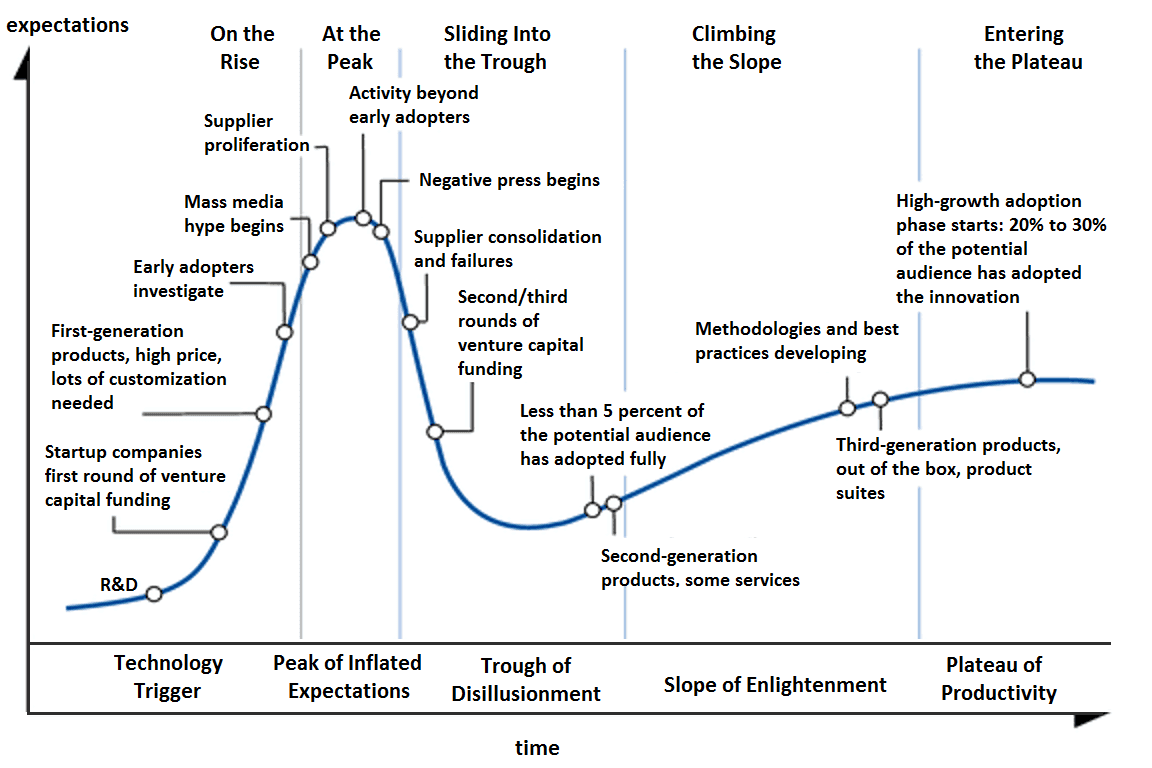Recent years have seen many new technologies emerge, such as blockchain and artificial intellegence, that have captured the world's attention and fueled waves of media hype. As a result, it can be difficult to determine which technologies are truly worth investing in and which are simply passing fads. Hype cycles, which are a visual representation of the maturity and potential of a technology or industry can help determine this.
What is a Hype Cycle?
Hype cycles were created by the IT research firm Gartner in 1995, as a way to represent the "life cycle" of a technology, from its creation to its maturity to its widespread usage and adoption. Every few years, a company or industry will make a claim that a new technology will revolutionize the world. Although some of these claims may be true, a majority fail to live up to their initial claims. Hype cycles are a way to identify the commerical viability of a technology and its potential to greatly change an industry.
The Five Stages of a Hype Cycle
Hype cycles are comprised of 5 stages, each of which represents a different phase in the "life cycle" of a technology: the Technology Trigger, the Peak of Inflated Expectations, the Trough of Disillusionment, the Slope of Enlightenment, and the Plateau of Productivity.

- Technology Trigger: The first stage of a hype cycle is called the "Technology Trigger". This phase represents the initial creation of a technology, during which R&D and inital startup funding occurs. During this phase, the technology is still in its infancy, and as a result, the technology is not yet widely known or used, and is only known to a small group of people. I would call this stage the "birthday".
- Peak of Inflated Expectations: The second stage of a hype cycle is called the "Peak of Inflated Expectations". During this phase, the technology has gained a lot of attention and media coverage, and as a result, the technology is overhyped and overvalued. During this phase, many companies will invest in the technology, and many startups will be created to capitalize on the hype. However, many of these companies are only set up to be short-term "profit-grabbers" and will fail, as the technology is still in its infancy and not yet ready for widespread adoption. I would call this stage the "hyper toddler".
- Trough of Disillusionment: The third stage of a hype cycle, called the "Trough of Disillusionment", is the phase in which the technology is at its lowest point. During this phase, many of the companies that were created during the "Peak of Inflated Expectations" will fail, and as a result, the technology will recieve a lot of negative media coverage. Consequently, many people will lose interest in the technology. Nevertheless, companies set up to be long-term players in the industry (during the "Technology Trigger" phase) will continue to invest in the technology, and the technology will therefore continue to develop and improve. I would call this stage the "midlife crisis".
- Slope of Enlightenment: The fourth stage of a hype cycle is known as the "Slope of Enlightenment". During this phase, various aspects of the technology will be deemed unnecessary or unviable, and will be removed. As a result, only the most important and useful aspects of the technology will remain. During this phase, the technology will also be adopted by a wider audience, and will therefore become more stable. The technology will recieve a good amount of media coverage, however it will focus on realistic use cases and applications of the technology, rather than its "potential to revolutionize the world", as was the case during the Peak of Inflated Expectations. I would call this stage "settling down".
- Plateau of Productivity: The fifth and final stage of a hype cycle is called the "Plateau of Productivity". At this point, more people are seeing real-world benefits, and the technology is widely adopted by enterprises. Less media coverage is given to the technology, as it is no longer a "hot topic", however the technology is now considered to be stable and mature. The technology goes mainstream, and is now used by a majority of the population. I would call this stage the "grandparent stage".
In conclusion, hype cycles serve as a valuable tool to analyze the potential of a technology or industry. They can reveal the estimated stage at which a technology is at, and can therefore be used to make predictions about the future of a technology or industry with a high degree of accuracy and clarity.